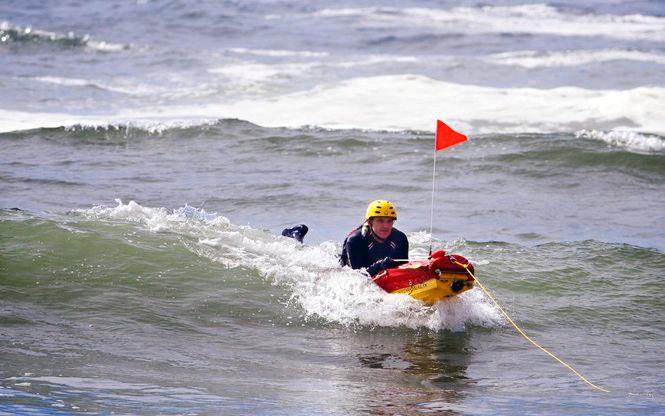Robotic lifeguard ‘Emily’ to assist lifeguards at beaches across the country
The Emily rescue system has been tested by lifeguards and is ready for use across the country. (Photo courtesy of Emilyrobot.com.)
A robot probably can’t patrol a beach by itself, but one may be able to help lifeguards with difficult rescues.
The Green Valley, Ariz.,-based company Hydronalix has created a robotic flotation device to deploy to swimmers in distress when a lifeguard can’t.
The robot is called Emily, which is short for Emergency Integrated Life-saving Lanyard. It weighs 25 pounds, can go up to 25 miles per hour and can be used as a flotation device for up to six people. Time Magazine chose it as one of the 50 best inventions in 2010.
Emily travels at twelve times the speed humans can run, works for about 20 minutes on batteries, and has already made a rescue. This month, in Depoe Bay, Ore., Emily helped a boy and his father get to shore, saving their lives.
Officers said without Emily, it would’ve taken at least half an hour to get the them back to the beach, rather than the 10 minutes it took Emily to return to shore.
Hydronalix Executive Vice President Robert Lautrup said the good thing about Emily is it’s very fast compared to a swimmer and can travel through large waves and heavy weather. It’s particularly useful in places like Oregon, where the conditions can be very dangerous.
“I’m talking 15, 20, 25-foot waves sometimes. It has a lot of rocks and boulders and things like that offshore, which, in heavy weather, the coast guard or other people are reluctant to put their boats in close to because they may founder,” Lautrup said.
Lautrup said that Emily does have certain limitations, but it can help get to drowning victims in conditions that are too dangerous for a lifeguard to attempt a rescue — for instance in a rip tide or rough weather.
The weather can also get so heavy that swimmers may not be permitted by local regulations to attempt rescues.
“And in this case, you can put Emily out in whatever kind of weather it is and stay onshore to make the rescue,” Lautrup said.
Emily can be dropped from a vessel, pier, by helicopter or carried to the shore and dropped in the water. It is a remote-controlled flotation device, electrically-driven and powered by batteries. It also has a flag so that in heavier weather, the operator can see how to direct Emily to the drowning victim.
Though Emily is very convenient, Lautrup said it isn’t a lifeguard replacement. Emily cannot rescue people caught under the surface of the water, and humans are needed for certain rescues. But, Lautrup said the upside is that Emily can propel itself to drowning victims to serve as a flotation device as they wait to be rescued.
“People that take that outlook about replacing the lifeguard don’t understand the value of professionals, thinking ahead, working to prevent drownings,” he said. “I think the professional lifeguards see it as another technical tool to make rescues either more quickly or with less risk under many circumstances.”
Currently, Los Angeles County Fire Department lifeguards have set up some Emilys for use and training. Green Valley also has Emily robots and lifeguards there have been training on it and developing techniques for whitewater rescues on the rivers and is areas of the community prone to flash-flooding.
In addition to Emily, Lautrup is working with NOAA to develop a device that can be dropped into the center of a hurricane and travel with the hurricane to provide environmental data like temperature, pressure and wind velocity at sea level, which isn’t always available.
